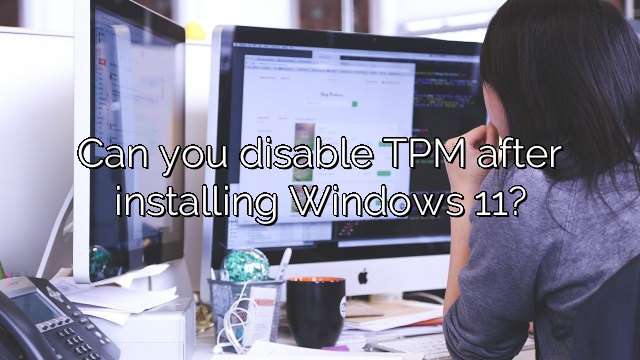
Can you disable TPM after installing Windows 11?
Yes, you can disable TPM and Secure Boot after installing Windows 11. You will have to go into UEFI and turn Secure Boot and TPM off.
How to install Windows 11 without TPM?
The minimum system requirements for a Windows 11 processor are 1 gigahertz (GHz) or possibly higher with at least the approximate number of cores on a 64-bit compatible processor, also known as SoC.
Memory: 4 GB
Memory: 64 GB
System Firmware: UEFI Compatible with Secure Boot
TPM: Trusted Platform Module 2.0
Video card: DirectX 12 or higher with 2 wddm.0 drivers
Display: 720p, 8-bit color channel, 9″ minimum diagonal
More articles
Why Windows 11 is forcing everyone to use TPM chips?
Computational requirements, dropping support for 32-bit kernels, for example, reflects Windows 95 dropping 286 and earlier cracks that supported Skin 11 well. This is probably a common problem.
How to upgrade Windows 10 to 11 without TPM?
Download and install the latest version of Rufus on your computer.
Insert an empty USB stick of 16 GB or more, then open Rufus.
Select the USB device where you want to install Windows 11.
Make sure the download selection says “Hard Drive or ISO Image” and click “DOWNLOAD”.
Select Windows 11 and beyond.
Select the latest version, click and continue.
How to enable TPM on Your Windows PC or laptop?
To access the firmware environment to enable your computer’s TPM chip at startup, follow these steps: Press the power button. Look at the boot screen to determine which button to press to access the firmware (if any). Press the desired button several times until you enter organization mode.
Can I turn off TPM after Windows 11 install?
Yes, and after installing Windows 11, you can disable TPM and Boot Secure. Secure boot should be disabled and UEFI settings entered in tpm.
Does Windows 11 actually need TPM?
The Windows 11 system requirements for a PC with TPM 2.0 may seem odd, but it’s always a must. Microsoft hopes to make Windows more stable with this technology, which is why it has made it the minimum requirement for its new device to work.
What happens if I disable Secure Boot Windows 11?
What happens after you disable secure boot. What happens after limiting this security feature is that the PC does not check if you are using an electronically signed operating system or not. However, you won’t feel any difference with Windows 11 or Windows 10 on your device.
Can you disable TPM after installing Windows 11?
Yes, you can disable TPM and also disable installing Secure Boot after Windows 10. You need to connect to UEFI and disable Secure Boot and in addition to that TPM. Currently, some features of Windows 11 require you to turn it on all the time. …Here are the known apps, games, and features of Windows 10 that depend on Secure Boot and TPM.
How does the clear TPM cmdlet reset the TPM?
The Clear-Tpm cmdlet resets the Trusted Platform Module (TPM) to its default state. Reset deletes the increased owner permission value and all keys stored in the TPM. To reset the TPM, you and your family must enter a valid owner penalty value.

Charles Howell is a freelance writer and editor. He has been writing about consumer electronics, how-to guides, and the latest news in the tech world for over 10 years. His work has been featured on a variety of websites, including techcrunch.com, where he is a contributor. When he’s not writing or spending time with his family, he enjoys playing tennis and exploring new restaurants in the area.










